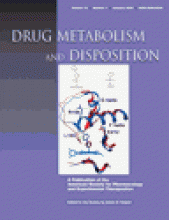Abstract
Exposure to certain xenochemicals can alter the catalytic activity of the major drug-metabolizing enzyme, CYP3A4, either by enhancing expression of this cytochrome P450 or inhibiting its activity. Such alterations can result in adverse consequences stemming from drug-drug interactions. A simplified and reliable tool for detecting the ability of candidate drugs to alter CYP3A4 levels or inhibit catalytic activity was developed by stable integration of human pregnane X receptor and a luciferase vector harboring the CYP3A4 enhancers. Treatment of stable transformants, namely DPX-2, with various concentrations of inducers including rifampicin, mifepristone, troglitazone, methoxychlor, and kava produced dose-dependent increases in luciferase expression (between 2- and 40-fold above dimethyl sulfoxide-treated cells). Northern blot analyses of CYP3A4 mRNA in DPX-2 cells exhibited a good correlation to results generated with the reporter gene assay (r2 = 0.5, p < 0.01). Induction of CYP3A4 protein was examined by measuring catalytic activity with the CYP3A4 substrate, luciferin 6′ benzyl ether (luciferin BE). Metabolism of luciferin BE by DPX-2 cells was enhanced 5.2-fold above dimethyl sulfoxide-treated cells by treatment with rifampicin. Constitutive androstane receptor-mediated regulation of CYP3A4 protein was addressed by measuring catalytic activity in a separate cell line over-expressing this receptor. Phenobarbital and dexamethasone produced 1.5- and 2.0-fold increases, respectively, above control in luciferin BE metabolism. To determine the utility of DPX-2 cells for identifying inhibitors of CYP3A4 catabolism, luciferin BE activity was measured in the presence of various concentrations of ketoconazole, erythromycin, or kava. These agents exhibited dose-dependent decreases in CYP3A4 activity with IC50 values of 0.3 μM for ketoconazole, 108 μM for erythromycin, and 15.5 μg/ml for kava. Collectively, DPX-2 cells were used to identify xenobiotics that induce or inhibit CYP3A4 in a high throughput manner, demonstrating their applicability to early-stage drug development.
Footnotes
-
This work was supported by National Institutes of Health Grants GM58287 (M.-F.Y.), GM49511 (J.R.), and AA08990 (J.R.) and by the Liver Transplant, Procurement, and Distribution System (N01-DK-9-2310).
-
doi:10.1124/dmd.104.001594.
-
ABBREVIATIONS: P450, cytochrome P450; PXR, pregnane X receptor; hPXR, human PXR; CAR, constitutive androstane receptor; hCAR, human CAR; luciferin BE, luciferin-6′ benzyl ether; ANF, α-naphthoflavone; PCN, pregnenolone 16α-carbonitrile; XREM, xenobiotic response element module; rRNA, recombinant RNA; DMEM, Dulbecco's modified Eagle's medium; FBS, fetal bovine serum; CITCO, 6-(4-chlorophenyl) imidazo [2,1-b][1,3] thiazole-5-carbaldehyde O-(3,4,dichlorobenzyl) oxime; HIV, human immunodeficiency virus; bp, base pair(s); RLU, relative light unit; AU, arbitrary unit(s); Ah, aryl hydrocarbon; TCDD, 2,3,7,8-tetrachlorodibenzo-p-dioxin.
- Received July 26, 2004.
- Accepted September 30, 2004.
- The American Society for Pharmacology and Experimental Therapeutics
DMD articles become freely available 12 months after publication, and remain freely available for 5 years.Non-open access articles that fall outside this five year window are available only to institutional subscribers and current ASPET members, or through the article purchase feature at the bottom of the page.
|






